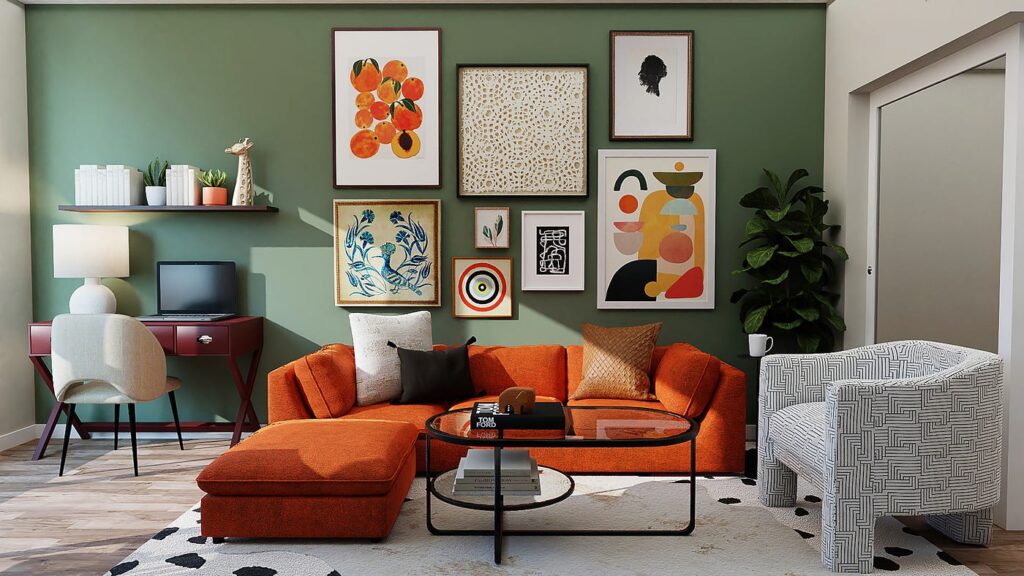Finding the right color palette during home remodeling might be challenging, but with some guidance, you can create a space that is not only harmonious but is personalized to your taste and needs. A well-chosen color scheme can transform a room, influencing mood, perception of space, and overall ambiance. This article provides some guides on how you can choose the perfect color palette for you.
The Golden Ratio of Interior Color Palette
In order to create a color palette for your home, the golden ratio is a useful principle to keep in mind. This principle suggests that a well-balanced color scheme should consist of three main colors: a dominant color, a secondary color, and an accent color.
Dominant Color: This is the primary color that sets the tone for the room. It covers the largest areas of the space, such as walls or large furniture pieces. Choose a color that you love and that will create the desired atmosphere – whether it’s calming, energizing, or cozy.
Secondary Color: This color complements the dominant color and is use in smaller proportions throughout the room. It can be use for upholstery, rugs, or curtains. Secondary colors should harmonize with the dominant color to create a cohesive look.
Accent Color: This is the smallest amount of color in the palette but plays a crucial role in adding interest and personality to the space. Accent colors can be introduced through accessories like pillows, artwork, or small decor items. They provide pops of color that draw the eye and create focal points within the room.
How Many Colors Can We Have?
While the golden ratio suggests three main colors, it’s important to remember that variations can occur. Some color palettes may include additional shades or tones to add depth and complexity. However, too many colors can overwhelm a space and make it feel chaotic.
A good rule of thumb is to limit your palette to no more than five colors, including shades and tints of your main three colors. This ensures a cohesive and balanced look while allowing for enough variety to keep the space interesting.
What Each Color Palette Represents
Colors evoke different emotions and moods, making it essential to choose hues that align with the atmosphere you want to create in each room:
Neutral Palettes: Shades like whites, grays, and beiges create a sense of calm and cleanliness. They are versatile and timeless, making them ideal for creating a serene atmosphere in bedrooms or living rooms.
Warm Palettes: Colors like reds, oranges, and yellows bring warmth and energy to a room. They are perfect for spaces where you want to promote activity and conversation, such as dining rooms or kitchens.
Cool Palettes: Blues, greens, and purples have a calming effect and are often use in bedrooms and bathrooms to promote relaxation and tranquility. These colors can make a room feel more spacious and serene.
Contrasting Palettes: Combining colors from opposite sides of the color wheel, such as blue and orange or purple and yellow, creates a dynamic and visually striking effect. Use these palettes sparingly to create focal points or add drama to specific areas of your home.
How to Pick Your Personal Color Palette
Choosing a color palette that reflects your personal style and preferences is key to creating a home that feels uniquely yours:
Consider Your Preferences: Start by identifying colors that you naturally gravitate towards. Look at your wardrobe, artwork, or favorite places for inspiration.
Think About Functionality: Consider the purpose of each room and how you want to feel when you’re in it. Bedrooms might benefit from soothing colors, while a home office might benefit from stimulating hues.
Test Colors: Before committing to a palette, test your chosen colors in the space. Paint swatches on the walls or try out different fabric samples to see how they look in different lighting conditions throughout the day.
Seek Harmony: Aim for a balance between your favorite colors and those that complement each other. Use the 60-30-10 rule: 60% dominant color, 30% secondary color, and 10% accent color to achieve a harmonious look.
Consult Experts: If you’re unsure about color combinations or need guidance, consult with interior designers or color experts who can provide personalized advice based on your preferences and space.
Expert Guidance in Crafting Harmonious Color Palettes
Achieving the perfect blend of colors in home remodeling can be a complex process. It requires a keen eye for design, a deep understanding of color theory, and the ability to envision how different hues will work together cohesively. At Flooring, Kitchen & Bath Design, we specialize in crafting color palettes that transform spaces with elegance and balance to create your ideal living space for you. Our team in Orange County, CA, is commit to creating a balanced space that not only enhances the aesthetic appeal of your home but also reflects your personal style and preferences.
Creating the perfect color palette for your home remodeling project requires careful consideration and a bit of creativity. By understanding the golden ratio of color palettes, knowing how many colors to include, understanding what each color represents, and following a thoughtful process to choose your personal color palette, you can transform your space into a harmonious and inviting environment tailored to your tastes and needs.

